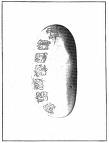One of the World's Leading
Sources of Information On Literature, the Arts, and a Wide Range of
Subjects
An Original Civilization
(This is taken from John D. Baldwin's Ancient America, originally published in 1871.)

It has been said, very justly, by one explorer of the Mexican and Central American ruins, that “the American monuments are different from those of any other known people, of a new order, and entirely and absolutely anomalous; they stand alone.” The more we study them, the more we find it necessary to believe that the civilization they represent was originated in America, and probably in the region where they are found. It did not come from the Old World; it was the work of some remarkably gifted branch of the race found on the southern part of this continent when it was discovered in 1492. Undoubtedly it was very old. Its original beginning may have been as old as Egypt, or even farther back in the past than the ages to which Atlantis must be referred; and it may have been later than the beginning of Egypt. Who can certainly tell its age? Whether earlier or later, it was original.
Its constructions seem to have been a refined and artistic development of a style of building different from that of any other people, which began with ruder forms, but in all the periods of its history preserved the same general conception. They show us the idea of the Mound-Builders wrought out in stone and embellished by art. The decorations, and the writing also, are wholly original. There is no imitation of the work of any people ever known in Asia, Africa, or Europe. It appears evident that the method of building seen in the great ruins began with the ruder forms of mound-work, and became what we find it by gradual development, as the advancing civilization supplied new ideas and gave higher skill. But the culture and the work were wholly original, wholly American.
The civilized life of the ancient Mexicans and Central Americans may have had its original beginning somewhere in South America, for they seem more closely related to the ancient South Americans than to the wild Indians north of the Mexican border; but the peculiar development of it represented by the ruins must have begun in the region where they are found. I find myself more and more inclined to the opinion that the aboriginal South Americans are the oldest people on this continent; that they are distinct in race; and that the wild Indians of the North came originally from Asia, where the race to which they belong seems still represented by the Koraks and Chookchees found in that part of Asia which extends to Behring’s Strait.
If, as there is reason to believe, the countries on the Mediterranean had communication with America in very ancient times, they found here a civilization already developed, and contributed nothing to change its style of building and decorating cities. They may have influenced it in other respects; for, if such communication was opened across the Atlantic, it was probably continued for a long time, and its interruption may or may not be due, as Brasseur de Bourbourg supposes, to the cataclysm which ingulfed Atlantis. Religious symbols are found in the American ruins which remind us of those of the Phśnicians, such as figures of the serpent, which appear constantly, and the cross, supposed by some to represent the mounting of the magnetic needle, which was among the emblems peculiar to the goddess Astarte. A figure appears occasionally in the sculptures, in which some have sought to recognize Astarte, one at Palenque being described as follows: “It is a female figure moulded in stucco, holding a child on her left arm and hand, just as Astarte appears on the Sidonian medals.” I find it impossible to see that this figure has any resemblance whatever to the Phśnician goddess. They are not alike either in dress, posture, or expression. Dupaix describes it correctly in saying it represents a person apparently “absorbed in devotion”—a worshiper, and not a goddess. Moreover, Astarte usually appears on the medals standing on the forward deck of a vessel, holding a cross with one hand, and pointing forward with the other. And, finally, this figure seems to represent, not a woman, but a priest. There was sun-worship in America, and the phallic ceremonies existed in some places in the time of Cortez. In Asia these ceremonies and figures of the serpent were usually associated with sun-worship. Humboldt was sure that these symbols came to America from the Old World. A more careful study of the subject might have led him to modify this belief. But, whether we adopt his explanation or some other, the traditions on both sides of the Atlantic are without meaning unless it be admitted that there was communication between the two continents in times of which we have no history.
Home | Book Collecting | Folklore / Myth | Philately | Playing Cards | Literature | Contents
